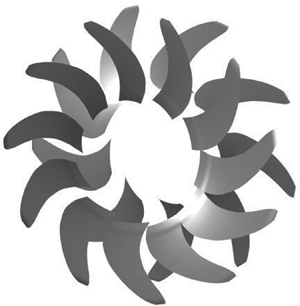Article contents
Time-domain analysis of contra-rotating propeller noise: wake interaction with a downstream propeller blade
Published online by Cambridge University Press: 28 August 2020
Abstract

This paper describes a theoretical study – in the time domain – of sound from the interaction of the steady component of the viscous wakes of an upstream propeller with a downstream contra-rotating propeller blade. The study incorporates a two-dimensional model of the upstream propeller wakes and a quasi-three-dimensional blade response function that accounts for downstream blade sweep. For a blade with a straight leading edge, the sound at the observer location, radiated from each blade radius, consists of a series of impulses whose peaks are shown to be influenced by micro Doppler effects and to correspond to the impingement of the propeller wake centrelines on the leading edge of the downstream blade. For radiation from the entire blade span, it is shown that constructive interference of the impulses from all radii can produce impulsive sound of very high amplitude, whereas dephasing of these impulses can reduce significantly the total acoustic signal. For a downstream propeller blade with a swept leading edge, it is shown how the sweep can be designed to ensure that these impulses are de-phased, resulting in significantly lower-amplitude sound at selected observer locations. Finally, to guarantee that the radiated sound is reduced at all possible observer locations, it is shown that the blade leading-edge sweep must be large enough that the trace velocity of the wake centreline, across the leading edge of the downstream propeller blade, is subsonic across the entire span. The benefits are demonstrated for representative blade designs.
JFM classification
Information
- Type
- JFM Papers
- Information
- Copyright
- © The Author(s), 2020. Published by Cambridge University Press
References
- 17
- Cited by


